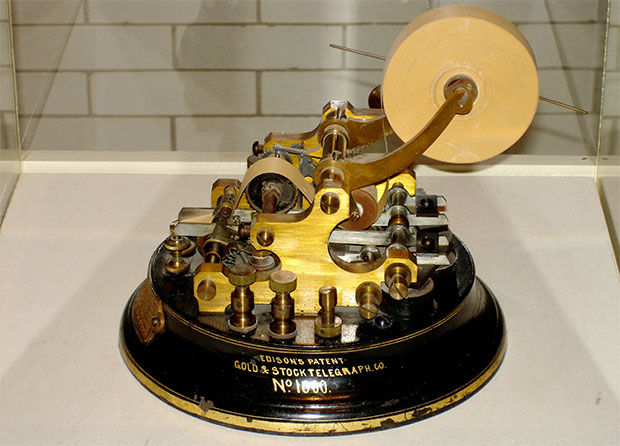Until the 1860’s, transmitting stock quotes (or the prices of gold and commodities) was difficult. The latest price per share was delivered by hand-written notes, or just verbally. Messengers hurried between the floor of the stock exchange and brokers’ offices. Data was delivered over distance by telegraph or mail.

Calahan and the Invention of the Stock Ticker
Finally on November 15th of 1867, a Bostonian named Edward A. Calahan revolutionized trading by introducing the stock ticker. Calahan was a Bostonian who was, as a boy, less interested in his studies than he was in business. He left school at age 11 and became a telegrapher for a company in New York later to be called Western Union (for reference see National Inventors Hall of Fame).
Calahan formed Gold & Stock Telegraph Company to market his invention, the stock ticker. Brokerage houses rented the ticker from his company for $6.00 a week. The first mechanical device for transmitting prices of stocks, gold and commodities, it was quickly adopted by the New York Stock Exchange.
Edison’s Contribution
At first the machine transmitted data using Morse code, but in 1869 that great innovator Thomas Edison introduced the universal stock printer, which improved efficiency by synchronizing the receiving tickers (see The Thomas Edison Papers). The ticker printed at a speed of about one character per second – sluggish by today’s standards, but impressive then.
The Stock Data
The invention’s name came from the ticking sound it made when printing the data. It produced several pieces of information:
- the stock’s ticker symbol (an abbreviated version of the company’s name),
- the volume of shares traded
- the stock price in the last trade
- an indication of whether the price has risen (using an uptick) or fallen (a downtick)
- the change in price
The Mechanism
The technology of the ticker was inventive. A telegraphic printing system had been invented about ten years before the stock ticker. It was used to input data to the ticker at the receiving end of the connection. The printing telegraph worked like a sort of typewriter, but looked more like a piano keyboard. It used black keys to transmit letters and white keys for numbers and fractions (see Early Office Museum). Its pulses activated two print wheels in the ticker – one for letters and the other for numbers. The data was printed out on narrow bands of white paper called ticker tape. Staff in the brokerage house monitored the ticker tape and posted prices on a wall board.
Advantages
By transmitting data to every participating broker in what was nearly real time, the stock ticker leveled the field of competition between them. Some professionals would argue that by facilitating the speed with which brokers could buy and sell stock, it made the stock market more efficient.
Limitations
For all its advantages of the ticker, there was still unmet needs in stock transactions. A ticker only relayed data in one direction. In order to make the trade, a trader still had to send a messenger or telegraph it in. Thus, some traders were at a disadvantage relative to others, and many missed the trade they intended because the price changed.
Obsolescence
In the 1960’s stock tickers had become obsolete by the 1960’s as the manually-noted boards were replaced by electronic boards and on-screen digital displays. Computer networks now operated in real time.
The technology by now is so advanced that speed-trading is possible, a trading mechanism that some analysts consider too fast, and dangerous to the market.
Jared Hallstatt writes on finance, taxation, technology in business, international trade, the national debt, and other prominent issues. To learn more check out R&G Brenner.
The Arrival and Passage of the Stock Ticker,





Tariqul
Nov 17. 2013
I really enjoyed the historical tech post. Thanks for your helpful article.
Arjun
Nov 18. 2013
nicely compiled one.
sbobet
Mar 16. 2014
I read this article completely about the difference of latest and
previous technologies, it’s awesome article.